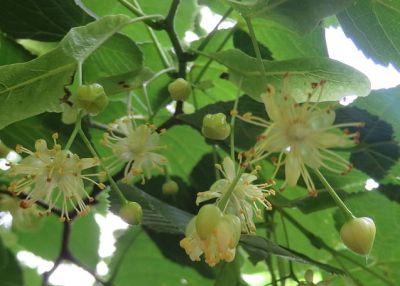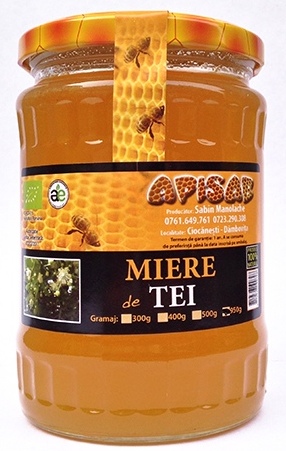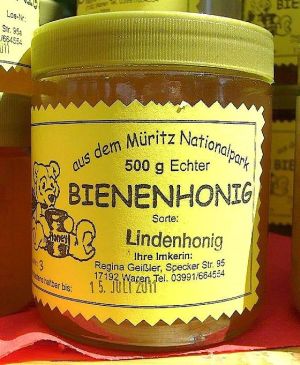 For thousands of years linden honey was the most appreciated honey. The scent of the tiny yellow-white flowers of those huge trees that blossom in late spring or early summer, have always attracted humans as well as bees.
For thousands of years linden honey was the most appreciated honey. The scent of the tiny yellow-white flowers of those huge trees that blossom in late spring or early summer, have always attracted humans as well as bees.
It is called basswood in America, lime in UK, and linden in Europe and Asia. (Though it is called “lime” it is not closely related to the lime fruit). But no matter the name, it belongs to the tilia genus, which has 30 species of trees, native throughout most of our Northern Hemisphere. The greatest species diversity is found in Asia.
The tree is reaching 20 to 40 meters (66 to 130 ft) tall, with oblique cordate leaves of 6 to 20 centimeters (2 to 8 in) across. The trees are hermaphroditic, having perfect flowers with both male and female parts, pollinated by insects.
In ancient Greek and Roman mythology there is a famous legend which tells ua about a poor Phrygian couple. For their hospitality, the gods rewarded them and made them immortal: they were turned into Linden and Oak.
Linden – is a national symbol of Slovenia. In the Slovenian town of Ruth there is a world-famous linden wood that is more than 850 years old, and the girth is more than 8 meters.
The names of cities of Australia, Europe and North America contain the word “linden” or “lime”. Perhaps because for millennia, linden was planted in the center of villages. where the people gathered later for events.
It was considered a mystical tree of life, tree of health, justice tree, tree of victory, a symbol of fertility and an object of worship.
Therapy
Linden flowers are used for:
• colds, flue, cough, fever, other disorders of the respiratory tract,
• infections,
• inflammation,
• high blood pressure,
• headache (particularly migraine),
• diuretic (increases urine production),
• antispasmodic (reduces smooth muscle spasm along the digestive tract),
• sedative.
• hepatoprotective
The double-flowered species are used to make perfumes.
The linden wood is used for:
• liver and gallbladder disorders
• cellulitis (inflammation of the skin and surrounding soft tissue)
• edema or ulcers of the lower leg.
• intestinal disorders (ingesting the wood that was burned to charcoal)
How is linden honey?
Color: white to pale yellow or greenish. Though the rule says that the darker the honey, the more saturated it is, this doesn’t apply to linden honey. Its white color does not change, except for when it’s crystallized.
Flavor: fresh woody with a hint of mint, balsamic and camphor aroma.
Aroma: the ripe honey is very thin and exquisitely fragrant.
Taste: sweet, sometimes with a touch of bitterness. After it you can always feel persistent aftertaste and light astringency. It is one of the most sweetest honey, as sweet as heather honey.
Does it crystallize?
 Yes, it does. After 3 (maximum 4) months the linden honey begins to crystallize: it thickens and loses its transparency. If you have a liquid linden honey in winter, then be sure you bought fake honey.
Yes, it does. After 3 (maximum 4) months the linden honey begins to crystallize: it thickens and loses its transparency. If you have a liquid linden honey in winter, then be sure you bought fake honey.
If you bought a white honey, and it is still liquid in the winter,
then unfortunately, you got a fake.
Composition of linden honey:
Just like all the honeys, it has a maximum of 20% water and an almost equal ratio of fructose and glucose. Yet, for the scientists it is still a mystery. Which is understandable considering that linden honey has about 400 substances and compounds.
From its distinctive features:
• maltose: Linden honey is rich in maltose, it contains about 6-8% of it, formed during the ripening of the product. This gives it a beneficial effect on our digestive system.
• vitamin B: Also compared to the other honeys it has a great number of vitamins, especially Vitamin B (B1, B2, B5, B6), nicotinic acid, Vitamin H, Vitamin PP, Vitamin C, tocopherol. In combination with all the other substances found in honey, it offers great therapeutic benefits to our health.
• macro-nutrients: than 40 different micro-and macro-nutrients, such as potassium, calcium, sulfur, copper, iodine, aluminum, nickel, phosphorus, chlorine, magnesium, manganese, zinc, cobalt etc.
• minerals are at exactly the same concentration as in the human blood, which makes them quickly absorbed by the body.
• organic and inorganic acids: gluconic, citric, lactic, malic, tartaric acid, linolenic acid, oxalic acid, succinic acid, hydrochloric acid and phosphoric.
 Click here to buy Bihophar Linden Creamy Honey-500 g, made in Germany, or SeeBees Linden Honey (16oz) (see picture)
Click here to buy Bihophar Linden Creamy Honey-500 g, made in Germany, or SeeBees Linden Honey (16oz) (see picture)
Therapeutic use of linden honey:
Linden flowers are widely used in phytotherapy as decoction or tea. It is logic then that honey will work in a similar form, only in a more concentrated way. In addition to what flowers do, the bees’ enzymes turn the whole product into pure medicine.
The regular use of linden honey helps to maintain adequate osmotic pressure at the cellular level, normalizes metabolism, has beneficial effects on digestion and hormonal activity.
 Colds:
Colds:
Due to its anti-bacterial properties linden honey prevents tonsillitis and controls the inflammation of respiratory organs. It facilitates the discharge of phlegm from the nose and throat. Honey with lemon juice is a good prophylactic against acute respiratory disease.
• For common colds: A teaspoon taken three times a day, with one hour before meals.
• For bad colds: First: stay in bed! Then take linden honey three times a day, instill into the nose 30% solution of linden honey in fresh red beet juice, like 5 to 6 drops into each nostril. Add a folk remedy made of 5 pounded leaves of aloe, a tablespoon of lime honey, two egg yolks and a bottle of Cahors.
Others give us another recipe: “pastils of linden honey, flour, mustard and sunflower oil. All ingredients should be mixed and applied before going to bed to the chest in the form of pellets”. Linden honey has high diaphoretic properties, so don’t go out after taking it. 🙂
Gastrointestinal problems like: gastritis, colitis, gastroenteritis
One tablespoon of linden honey, dissolved in warm water, three times a day over a long period of time.
It reduces the hypersecretion of hydrochloric acid in the stomach (in the form of heat) or, on the contrary, it increases it (in the cold state). It is widely used in combination with the decoction of the juice of fresh cabbage, village butter, kernels.
A cup of tea with linden honey is also useful in the treatment of liver and gallbladder.
It has diuretic and laxative effects which makes it good in detoxification as well.
Eye conditions
Linden honey contains substances that are beneficial to the retina. All computer users should eat it with trust!
Sore eyes can be washed with a solution of this honey.
Contraindications:
• linden honey should not be consumed by people with acute heart failure, who had heart valve surgery, or are suffering from pulmonary hemorrhage.
• pregnant women, especially in the last semester because the compounds in honey thins the blood and raise the risk of postpartum hemorrhage.
• people with anemia, because it obstructs the iron absorption
• drivers, because it is diaphoretic and can bring sleepiness.
Other types of honey:
Mint Honey
Manuka honey
Lifemel honey
Ikaria honey
Sidr honey
Tualang honey
Mad honey
Sunflower honey
references:
http://keepingbee.org/linden-honey/;
http://en.wikipedia.org/wiki/Monofloral_honey;
http://www.honeytraveler.com/single-flower-honey/linden-lime-basswood-honey/;
pictures credit:
“basswood tree” picture credit Herman DE, USDA-NRCS PLANTS Database, via wikimedia commons
“linden flowers” picture credit Nickispeaki, via wikimedia commons
“Romanian linden honey” picture credit apisab.ro
“German linden honey” picture credit mueritz (Thomas Kohler) via wikimedia commons

